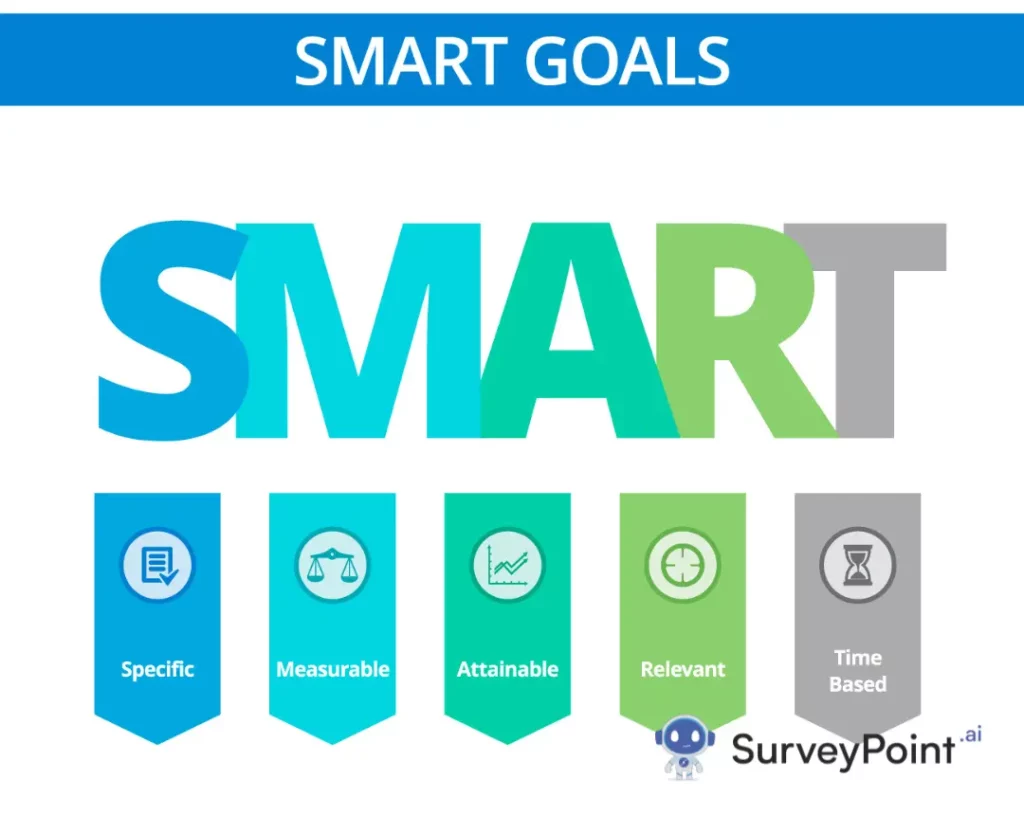
In the pursuit of personal and professional development, setting goals is essential. However, not all goals are created equal. To maximize effectiveness and increase the likelihood of success, it’s crucial to employ the SMART criteria. SMART goals are Specific, Measurable, Attainable, Realistic, and Timely. In this comprehensive guide, we’ll delve into the meaning of SMART goals, their importance, and provide real-life examples to illustrate their application.
What are SMART Goals?
SMART goals serve as a framework for setting objectives that are clear, achievable, and conducive to success. Let’s break down each component:
SMART goals are a framework for setting objectives that are Specific, Measurable, Achievable, Realistic, and Timely. Each component plays a crucial role in ensuring that goals are well-defined, attainable, and conducive to success.
- Specific:
The specificity of a goal refers to how well-defined and clear it is. Specific goals answer the questions of what, why, and how. They outline exactly what needs to be achieved and provide clarity on the desired outcome. For example, instead of setting a vague goal like “lose weight,” a specific goal would be “lose 10 pounds in three months by following a balanced diet and exercising three times a week.” This specificity provides a clear direction and helps individuals focus their efforts effectively. - Measurable:
Measurable goals have specific criteria that enable progress tracking and evaluation. They provide tangible evidence of whether the goal has been achieved or not. Measuring progress helps individuals stay accountable and motivated. For instance, instead of setting a goal like “improve productivity,” a measurable goal would be “increase sales by 20% in the next quarter.” This allows for quantifiable assessment and adjustments as needed to ensure progress towards the desired outcome. - Achievable:
An achievable goal is realistic and within reach. It challenges individuals to push beyond their comfort zones but is attainable given their abilities, resources, and constraints. Setting goals that are too ambitious can lead to frustration and demotivation. For example, instead of aiming to run a marathon without any prior training, an achievable goal would be to complete a 5k race within three months after gradually increasing running distance and endurance. This ensures that goals are challenging yet feasible, increasing the likelihood of success. - Realistic:
Realistic goals are aligned with an individual’s capabilities and circumstances. They are relevant to their life purpose and contribute positively to their overall growth and well-being. Setting goals that are unrealistic or impractical can lead to disappointment and disillusionment. For instance, instead of aspiring to become a billionaire overnight, a realistic goal would be to attain a promotion within the next two years by gaining relevant experience and skills. This ensures that goals are meaningful and attainable, fostering a sense of satisfaction and accomplishment. - Timely:
Timely goals have a clearly defined timeline, including a starting date and a target date for completion. Establishing deadlines creates a sense of urgency and prevents procrastination. It also allows individuals to prioritize tasks and allocate resources effectively. For example, instead of setting an open-ended goal like “learn a new language someday,” a timely goal would be “complete a beginner’s language course within six months.” This ensures that goals are pursued with purpose and determination, leading to timely achievements.
These components of SMART goals work together to create a framework for setting objectives that are clear, measurable, achievable, realistic, and timely. By incorporating these elements into goal-setting processes, individuals can enhance focus, motivation, and accountability, ultimately increasing their chances of success across personal and professional endeavors.
Specific SMART Goals:
Specific goals narrow down your focus and provide clarity. For example:
- Instead of “I want to get fit,” a specific goal would be “I will run 5 miles three times a week.”
Measurable SMART Goals:
Measurable goals allow you to track progress and determine success. For instance:
- Instead of “I want to save money,” a measurable goal would be “I will save $500 per month for a down payment on a house.”
Achievable SMART Goals:
Achievable goals are challenging yet within reach. For example:
- Instead of “I want to become fluent in a new language in a month,” an achievable goal would be “I will dedicate 30 minutes every day to language study and aim to hold a basic conversation in six months.”
Realistic SMART Goals:
Realistic goals are feasible given your current circumstances. For instance:
- Instead of “I want to become CEO of a Fortune 500 company next year,” a realistic goal would be “I will gain leadership experience by taking on a management role within my department in the next two years.”
Timely SMART Goals:
Timely goals have a defined timeframe for completion. For example:
- Instead of “I want to write a book someday,” a timely goal would be “I will outline my book by the end of this month and complete the first draft within six months.”
The Importance of SMART Goal Setting:
SMART goal setting provides numerous benefits, including:
- Clarity and Focus: SMART goals clarify your objectives and help you stay focused on what truly matters.
- Accountability: Measurable criteria make it easy to track progress and hold yourself accountable.
- Motivation: Achievable goals provide a sense of accomplishment and motivation to keep pushing forward.
- Time Management: Timely goals prevent procrastination and help you manage your time effectively.
- Achievement: Realistic goals increase the likelihood of success, boosting your confidence and self-esteem.
Real-Life Examples:
- Career Development: “Within the next year, I will complete a professional certification relevant to my field to enhance my skills and increase my earning potential.”
- Health and Fitness: “Over the next six months, I will lose 20 pounds by following a balanced diet and exercising regularly.”
- Financial Planning: “By the end of this year, I will have an emergency fund of $10,000 saved to provide financial security for unexpected expenses.”
- Personal Growth: “Within three months, I will learn to play the guitar by dedicating 30 minutes of practice each day.”
- Time Management: “Starting next week, I will establish a daily routine and allocate specific time slots for work, exercise, and leisure activities to improve productivity and work-life balance.”
Conclusion
In conclusion, SMART goal setting is a powerful tool for achieving success in various aspects of life. By applying the principles of Specific, Measurable, Achievable, Realistic, and Timely goals, you can clarify your objectives, stay motivated, and increase your chances of success. Whether you’re pursuing career advancement, health and fitness goals, financial stability, or personal growth, SMART goals provide a roadmap for turning your aspirations into reality. So, set SMART goals, take action, and watch your dreams transform into achievements.




